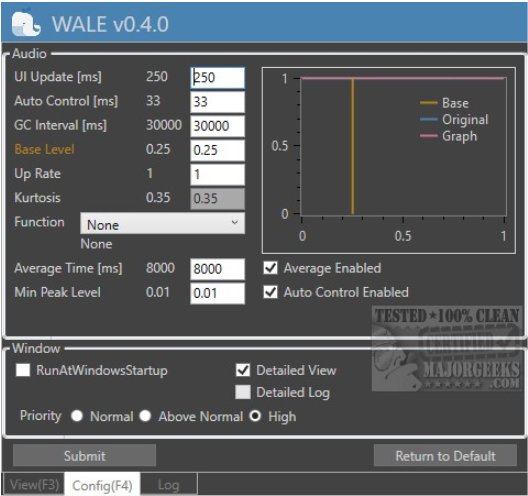Windows Audio Loudness Equalizer Enables Custom Control of Volume, Equalization Levels
By Timothy Tibbettson 06/15/2023 |
Windows Audio Loudness Equalizer will help you to control each applications volume separately as well as attempting to equalize peak levels for each app to your preferred level.
Windows Audio Loudness Equalizer can be installed or used as a portable app. After installation, you'll find Windows Audio Loudness Equalizer in your system tray. Be sure to look for 'RunAtWindowsStartup' under the config section.
 majorgeeks.jpg)
Windows Audio Loudness Equalizer can be a bit intimidating to those who aren't audiophiles, however, a few settings should get you on your way.
There are three tabs included; View, Config, and Log. Under the View tab, you can find, Base, Master, System Sound, and a few additional settings. Our best guess is to set the Master target volume and Base volumes in the main window or the View tab.
Under the Config tab, there are about fifteen settings and a graph that can be very useful. You can set the UI Updates, GC Interval, Kurtosis (the sharpness of the peak of a frequency-distribution curve - yeah, we had to look that one up), Priority, and more. If you've lost track of your settings, you can reset to default here as well.
Windows Audio Loudness Equalizer is an excellent idea. We'd love to see some mouseover tips or help to explain what some things do.
Download @ https://www.majorgeeks.com/files/details/windows_audio_loudness_equalizer.html
comments powered by Disqus
Windows Audio Loudness Equalizer can be installed or used as a portable app. After installation, you'll find Windows Audio Loudness Equalizer in your system tray. Be sure to look for 'RunAtWindowsStartup' under the config section.
 majorgeeks.jpg)
Windows Audio Loudness Equalizer can be a bit intimidating to those who aren't audiophiles, however, a few settings should get you on your way.
There are three tabs included; View, Config, and Log. Under the View tab, you can find, Base, Master, System Sound, and a few additional settings. Our best guess is to set the Master target volume and Base volumes in the main window or the View tab.
Under the Config tab, there are about fifteen settings and a graph that can be very useful. You can set the UI Updates, GC Interval, Kurtosis (the sharpness of the peak of a frequency-distribution curve - yeah, we had to look that one up), Priority, and more. If you've lost track of your settings, you can reset to default here as well.
Windows Audio Loudness Equalizer is an excellent idea. We'd love to see some mouseover tips or help to explain what some things do.
Download @ https://www.majorgeeks.com/files/details/windows_audio_loudness_equalizer.html
comments powered by Disqus






